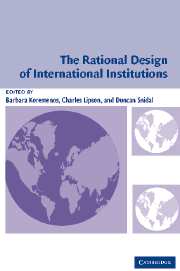Book contents
- Frontmatter
- Contents
- Contributors
- Abstracts
- Title Page
- The Rational Design of International Institutions
- Trust Building, Trust Breaking: The Dilemma of NATO Enlargement
- The Optimal Design of International Trade Institutions: Uncertainty and Escape
- Most-Favored-Nation Clauses and Clustered Negotiations
- Situation Structure and Institutional Design: Reciprocity, Coercion, and Exchange
- Private Justice in a Global Economy: From Litigation to Arbitration
- Multilateralizing Trade and Payments in Postwar Europe
- The Institutional Features of the Prisoners of War Treaties
- Institutions for Flying: How States Built a Market in International Aviation Services
- Driving with the Rearview Mirror: On the Rational Science of Institutional Design
- Rational Design: Looking Back to Move Forward
- References
The Rational Design of International Institutions
Published online by Cambridge University Press: 28 October 2009
- Frontmatter
- Contents
- Contributors
- Abstracts
- Title Page
- The Rational Design of International Institutions
- Trust Building, Trust Breaking: The Dilemma of NATO Enlargement
- The Optimal Design of International Trade Institutions: Uncertainty and Escape
- Most-Favored-Nation Clauses and Clustered Negotiations
- Situation Structure and Institutional Design: Reciprocity, Coercion, and Exchange
- Private Justice in a Global Economy: From Litigation to Arbitration
- Multilateralizing Trade and Payments in Postwar Europe
- The Institutional Features of the Prisoners of War Treaties
- Institutions for Flying: How States Built a Market in International Aviation Services
- Driving with the Rearview Mirror: On the Rational Science of Institutional Design
- Rational Design: Looking Back to Move Forward
- References
Summary
International institutions are central features of modern international relations. This is true of trade, international debt and financial restructuring, and even national security, once the exclusive realm of pure state action. It was certainly true of the two major military engagements of the 1990s, the wars in Kosovo and the Persian Gulf. As international institutions have gained prominence in the political landscape, they have increasingly become prominent topics for study. The sharpest debate among researchers has been theoretical: Do international institutions really matter? Missing from this debate is a sustained inquiry into how these institutions actually work. We shift the focus by posing researchable questions about how they operate and how they relate to the problems states face.
We begin with a simple observation: major institutions are organized in radically different ways. Some are global, essentially open to all states; others are regional, with restricted memberships. Some institutions give each state an equal vote, whereas others have weighted voting and sometimes require supermajorities. Institutions may have relatively strong central authorities and significant operating responsibilities or be little more than forums for consultation. Some arrangements—for example, most bilateral treaties—have no formal organizational structure; these are plentiful because states have a striking tendency to codify their relationships in formal, legal arrangements.
Why do these differences exist? Do they really matter, both for members and for international politics more generally? Do they affect what the institutions themselves can do? We focus on these large questions of institutional design.
- Type
- Chapter
- Information
- The Rational Design of International Institutions , pp. 1 - 40Publisher: Cambridge University PressPrint publication year: 2003
- 16
- Cited by



